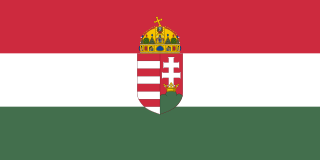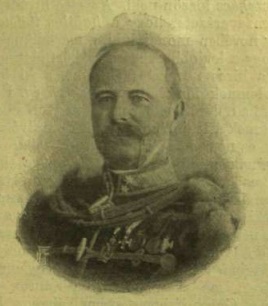
The King of Hungary was the ruling head of state of the Kingdom of Hungary from 1000 to 1918. The style of title "Apostolic King of Hungary" was endorsed by Pope Clement XIII in 1758 and used afterwards by all Monarchs of Hungary.

Emeric Thököly de Késmárk was a Hungarian nobleman, leader of anti-Habsburg uprisings like his father, Count István Thököly, before him. Emeric was Prince of Upper Hungary, an Ottoman vassal state, from 1682 to 1685, and briefly Prince of Transylvania during the year 1690. Having formed an alliance with the Turks, Thököly assisted the Ottoman Empire at the Battle of Vienna in 1683 and led the Turkish cavalry at the battle of Zenta. Refusing to surrender to Habsburg Emperor Leopold I, Thököly lost his principality of Upper Hungary and finally retired to Galata, near Constantinople, with large estates granted him by Mustafa II.
The Árpád dynasty consisted of the members of the royal House of Árpád, also known as Árpáds. They were the ruling dynasty of the Principality of Hungary in the 9th and 10th centuries and of the Kingdom of Hungary from 1000 to 1301. The dynasty was named after the Hungarian Grand Prince Árpád who was the head of the Hungarian tribal federation during the conquest of the Carpathian Basin, c. 895. Previously, it was referred to as the Turul dynasty or kindred.

Alajos Hauszmann was a Hungarian architect, professor, and member of the Hungarian Academy of Sciences.

The First Hungarian Republic, until 21 March 1919 the Hungarian People's Republic, was a short-lived unrecognized country, which quickly transformed into a small rump state due to the foreign and military policy of the doctrinaire pacifist Károlyi government. It existed from 16 November 1918 until 8 August 1919, apart from a 133-day interruption in the form of the Hungarian Soviet Republic. The republic was established in the wake of the dissolution of Austria-Hungary following World War I as a replacement for the Kingdom of Hungary, During the rule of Count Mihály Károlyi's pacifist cabinet, Hungary lost control over approximately 75% of its former pre-World War I territories, which was about 325,411 km2 (125,642 sq mi), without armed resistance and was subjected to unhindered foreign occupation. It was in turn succeeded by the Hungarian Soviet Republic but re-established following its demise, and ultimately replaced by the Hungarian Republic.
The coins of the Austro-Hungarian krone were minted with a different design in Austria and Hungary.
József Petrétei is former Minister of Justice in Hungary. The office was renamed to Ministry of Justice and Law Enforcement after the 2006 election.

The Black Army, also called the Black Legion/Regiment – were the military forces serving under the reign of King Matthias Corvinus of Hungary. The ancestor and core of this early standing mercenary army appeared in the era of his father John Hunyadi in the early 1440s. The idea of the professional standing mercenary army came from Matthias' juvenile readings about the life of Julius Caesar.

The Roman Catholic Archdiocese of Kalocsa–Kecskemét is an archdiocese of the Latin Church of the Roman Catholic Church in Hungary. The diocese is the metropolitan of the Diocese of Pécs and the Diocese of Szeged–Csanád. Its patron saint is Saint Paul. The current archbishop is Balázs Bábel, who was appointed in 1999.
The Treaty of Ófalu was a peace treaty signed by the Kingdom of Poland and the Kingdom of Hungary in 1474.
The Battle of Leitzersdorf was a battle between the Holy Roman Empire and the Kingdom of Hungary in 1484. Fuelled by the earlier conflicts of Matthias Corvinus and Frederick III, Holy Roman Emperor it marked the end of anti-Ottoman preparations and initiations of a holy war. It was the only open field battle of the Austro-Hungarian War, and the defeat meant – in long terms – the loss of the Archduchy of Austria for the Holy Roman Empire.
The siege of Hainburg were two sieges of Hainburg conducted by Matthias I, King of Hungary, during the Austro-Hungarian War (1477–88). The first siege was broken in July 1482 by the Imperial Army of the Holy Roman Empire. Corvinus laid siege to the town again in August 1482, this time with better preparations, and took Hainburg in September 1482.

The Hungarian Republic was a short-lived republic that existed between August 1919 and February 1920 in the central and western portions of the former First Hungarian Republic. The state was established in the aftermath of the Hungarian–Romanian War by counter-revolutionary forces who sought to return to the status quo prior to 31 October 1918.
Thomas (I) Szécsényi was a Hungarian powerful baron and soldier, who rose to prominence during King Charles I's war against the oligarchs. He belonged to the so-called "new aristocracy", who supported the king's efforts to restore royal power in the first decades of the 14th century. He was the first member of the influential Szécsényi family.

Béla Pap de Szill was a Hungarian military officer and politician, who served as Minister of Defence from March to April 1906, during the Hungarian Constitutional Crisis of 1905.

The Bocskai uprising, known in Hungary as Bocskai's War of Independence was a revolt which took place in Hungary, Transylvania and modern Slovakia during the Long Turkish War against Emperor Rudolf II. The rebel leader was Stephen Bocskai, a Protestant Hungarian nobleman. The Ottoman wars had burdened the Kingdom of Hungary for years, causing famine and disease, and the armies of the Christian states had been weakened by losses to Ottoman and Tatar forces.

Enikő A. Sajti is a Hungarian historian and professor emerita of Faculty of Arts, University of Szeged. She has been active in research of the relationship between Serbia & Croatia (Yugoslavia) and Hungary for decades. She is a notable and respected scientist both in Hungary and around the world.

This is a list of writings published by the Hungarian historian Sándor Csernus. He has written and published his works in Hungarian, English, German, and French.





























